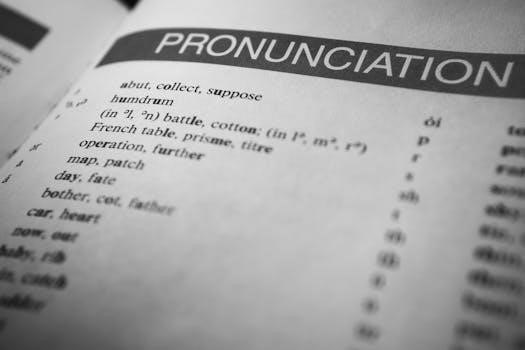Wordslut, by Amanda Montell, is a feminist exploration of the English language, revealing its inherent biases. It aims to equip readers with linguistic knowledge to challenge misogynistic language. Montell, a self-proclaimed “linguistics nerd,” provides insights into how language shapes societal perceptions of women.
Amanda Montell’s Feminist Linguistics Approach
Amanda Montell, a feminist linguist, adopts an approach in Wordslut that is both scholarly and accessible, blending academic rigor with a casual, conversational tone. She presents complex linguistic concepts in an easily digestible manner, making the subject matter engaging for a broad audience. Montell’s style is characterized by her enthusiastic and informal delivery, akin to an excited friend sharing interesting discoveries. Her approach is not merely to inform, but to empower readers with the tools to critically analyze and challenge the gendered nuances of language. She aims to disrupt the status quo, advocating for precise communication that dismantles patriarchal structures embedded in the English language, while also encouraging readers to embrace new language usage.

Core Themes of ‘Wordslut’
This work delves into the patriarchal influences on language, examining how it perpetuates gender inequality. It also focuses on reclaiming language used to demean women, promoting linguistic empowerment.
Language and the Patriarchy
Wordslut meticulously dissects how the English language has been shaped by patriarchal structures, embedding biases that often go unnoticed. Montell argues that language is not neutral but rather a powerful tool that reflects and reinforces societal power dynamics. She explores how the very fabric of our vocabulary, grammar, and even our idioms are often rooted in male-centric perspectives, subtly marginalizing women and their experiences. The book reveals how historical power imbalances have left lasting imprints on our linguistic landscape, contributing to the perpetuation of stereotypes and the erasure of female voices. This exploration encourages readers to recognize and critically examine the ways language reinforces the patriarchy. The work highlights how language actively denies women an active role in society.
Reclaiming Gendered Language
Wordslut advocates for a proactive approach to reclaiming gendered language, urging readers to become conscious agents of linguistic change. Montell emphasizes the power of awareness in recognizing and challenging the subtle ways language perpetuates harmful stereotypes; She encourages actively questioning traditional word usage and embracing new linguistic forms that foster inclusivity and equality. The book argues that by understanding the origins and implications of gendered terms, we can begin to dismantle their power. This is not just about avoiding offensive language, but about actively creating a lexicon that accurately represents the diverse experiences of all individuals, thereby disrupting the status quo. Reclaiming gendered language is presented as a revolutionary act.

Key Concepts Explored
This section delves into the core ideas presented, including the sexist history of English and the linguistic biases that disadvantage women. These concepts form the basis of Montell’s arguments for change.
The Sexist History of English
Montell meticulously explores how the English language has evolved through a patriarchal lens, revealing deep-seated biases in its structure and vocabulary. She uncovers how historical power imbalances have shaped the very words we use, embedding inequality into our daily communication. This historical analysis highlights the ways in which language has historically marginalized women, limiting their agency and perpetuating stereotypes. The book examines the origins of gendered slurs and how they have been used to control and demean women throughout history. By understanding the historical roots of these linguistic biases, Montell empowers readers to recognize and challenge the subtle ways in which language continues to reinforce patriarchal structures. This exploration emphasizes that the current state of language is not neutral but a result of historical and social forces, providing a necessary framework for feminist linguistic analysis.
Linguistic Bias Against Women
Montell’s work delves into the pervasive linguistic bias against women, showcasing how language often diminishes or devalues their contributions. She exposes the ways in which language subtly reinforces stereotypes and limits the perceived capabilities of women; The book provides examples of how language is used to infantilize, sexualize, or silence women, often through seemingly innocuous phrases and word choices. Montell analyses the use of gendered language, demonstrating how it perpetuates inequality and reinforces patriarchal assumptions. The text reveals how women’s speech patterns are frequently judged more harshly than men’s, impacting how they are perceived in professional and social settings. Through her analysis, Montell encourages readers to become more aware of these biases and actively challenge the language norms that contribute to gender inequality, advocating for more inclusive communication.

Reception and Impact
The book has garnered positive feedback for its witty and informative approach to feminist linguistics. Readers praise its accessible style and its ability to shed light on gender biases in language.
Positive Reviews and Reader Engagement
Wordslut has received considerable acclaim for its engaging and insightful approach to feminist linguistics. Many reviews highlight the book’s ability to make complex linguistic concepts accessible to a general audience, praising Montell’s blend of humor and informative content. Readers often express that the book has profoundly changed their perspectives on language and its relationship to gender. The book’s casual and conversational tone has resonated with many, creating an experience akin to learning from an enthusiastic friend. Numerous readers have stated they would recommend Wordslut to anyone, emphasizing its impact on their views regarding language. The book’s ability to spark laughter while contemplating the power of words has been noted as a significant strength. Overall, reader engagement reflects a strong appreciation for the book’s ability to enlighten and entertain.
Criticisms and Limitations
While Wordslut has garnered much praise, some criticisms have been noted. One area of concern revolves around the book’s use of contemporary slang, which some reviewers find may limit its long-term relevance. Additionally, the lack of a comprehensive index has been pointed out as a drawback, making it more challenging to use as a reference tool. Some critics suggest that while the book serves as a good introduction, its exploration of complex issues may be somewhat superficial. The book’s focus on the English language is also seen as a potential limitation, as it may not fully address the nuances of other languages and cultures. Furthermore, some have argued that the book’s casual tone, while engaging, might undermine its credibility with certain academic readers. Despite these points, the book’s overall impact remains positive.

Montell’s Style and Tone
Montell’s writing in Wordslut is described as both informative and entertaining. Her style is casual and conversational, making complex linguistic concepts accessible. It feels like an excited friend sharing discoveries.
Informative and Entertaining Approach
Amanda Montell masterfully blends education and amusement in Wordslut, creating an experience that is both enlightening and enjoyable. The book doesn’t shy away from complex linguistic concepts, yet it presents them in a way that is engaging and easy to grasp. Montell’s ability to make the reader laugh while also considering the power of words makes the book unique. This approach is crucial in making the subject matter appealing to a broader audience, thus, fostering a wider discussion on language and gender. The book uses both wit and well-researched information, offering a perspective on language that is as entertaining as it is instructive.
Casual and Conversational Style
Montell adopts a casual and conversational tone throughout Wordslut, akin to a friend sharing exciting new discoveries. This informal style makes the book approachable and accessible. The writing is far from academic, avoiding jargon and instead using a relatable language. This approach allows readers to easily engage with complex linguistic ideas without feeling overwhelmed. The friendly and conversational style enhances the book’s overall appeal, creating a comfortable reading experience, and this encourages readers to thoughtfully consider the impact of language in their daily lives. The author’s enthusiasm for the subject matter is contagious, making learning feel natural and fun.





